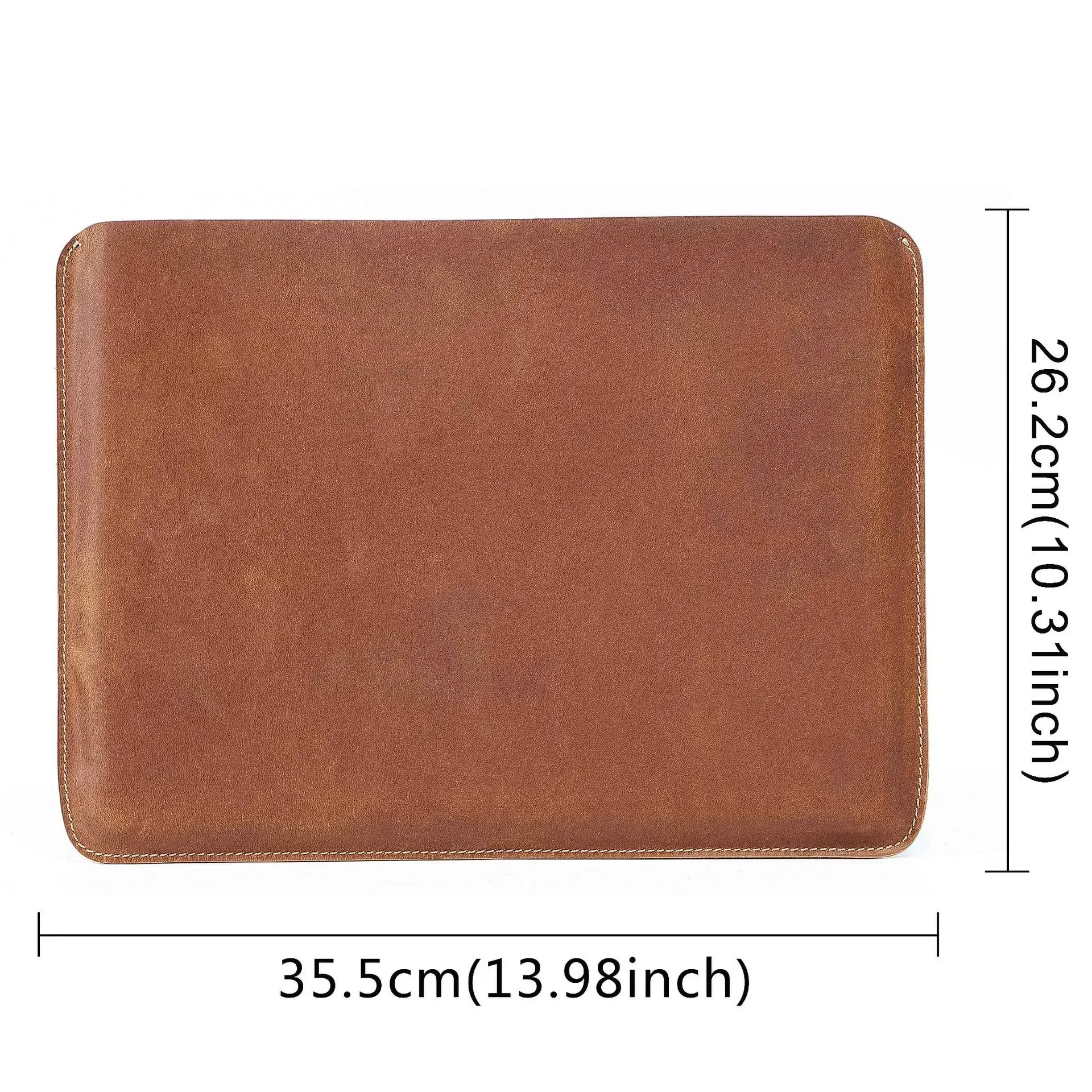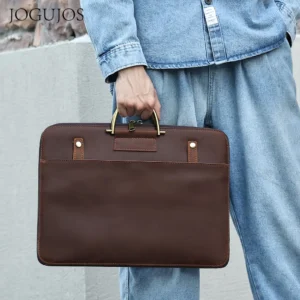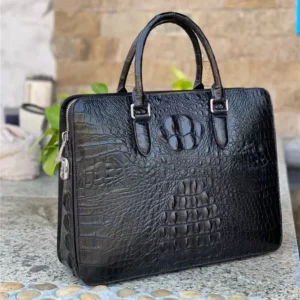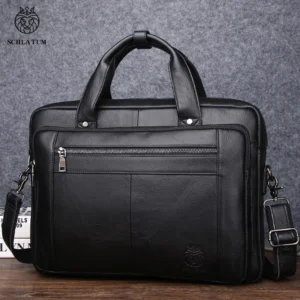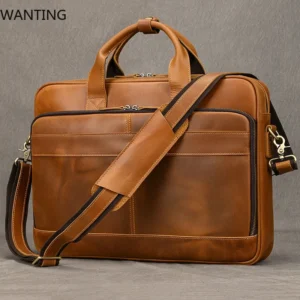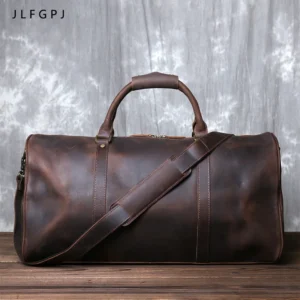Understanding Leather Basics
Leather is one of nature’s most remarkable materials, created from animal hides through specialized processing. At its core, leather production involves taking raw animal skin and transforming it through tanning—a preservation process that converts perishable hide into durable, flexible material that can last for decades.
Before making any leather purchase, understanding the basics helps you make smarter decisions:
- Tanning is the fundamental process that preserves leather, with two main methods:
- Vegetable tanning: Uses natural plant materials, creates rich patina over time
Chrome tanning: Uses chemicals for faster processing, creates softer leather
Leather grades indicate quality levels, with significant differences between types
- Quality indicators include thickness, fiber density, and surface characteristics
The type of leather directly affects how your item will perform over time, its appearance after years of use, and whether it represents good value for your investment. Understanding the differences between classic leather briefcase options gives you the knowledge to evaluate what you’re really getting for your money.
What is Full-Grain Leather?
Full-grain leather represents the highest quality grade available in the leather market. This premium material is created from the outermost layer of the animal hide with its natural surface completely intact. What makes it special is what isn’t done to it—the hide undergoes minimal processing without any sanding or buffing to remove imperfections.
Key defining aspects of full-grain leather include:
- Comes from the top layer of the hide where fiber structure is densest and strongest
- Retains all natural markings, character elements, and unique patterns
- Undergoes minimal processing beyond the essential tanning process
- Contains the complete natural grain pattern with its original texture
- Shows visible natural history including growth lines, small scars, and subtle variations
These natural characteristics are precisely what give full-grain messenger bags their distinctive appearance and exceptional durability. Each piece tells its own story through unique markings—similar to the way each person has unique fingerprints.
Full-grain leather displays small variations in texture, natural marks from the animal’s life, and a distinctive surface that feels substantial to the touch. The complete, undamaged fiber structure provides unmatched strength and durability, which explains why full-grain is the material of choice for premium leather goods meant to last for generations.
Key Characteristics of Full-Grain Leather
Exceptional Durability
Full-grain leather’s outstanding durability comes from its intact natural fiber structure. The tightly packed fibers at the hide’s surface remain undisturbed during processing, retaining their natural strength and resilience. This structure allows full-grain leather to resist tearing, puncturing, and everyday wear that would damage lesser materials.
Beautiful Patina Development
One of full-grain’s most prized qualities is how it develops a rich patina over time. With regular use, the leather absorbs oils from handling, develops subtle color variations, and forms a lustrous sheen that becomes more beautiful as years pass. This natural aging process creates a personalized appearance that tells the story of the item’s journey with you.
Natural Character
Each piece of full-grain leather retains distinctive markings from the animal’s life—small scars, wrinkles, growth patterns, and subtle color variations. These natural elements create character and authenticity that mass-produced materials simply cannot replicate.
Superior Breathability
The natural, open pore structure of full-grain leather allows air circulation, making it comfortable in products that contact your body. This breathability helps regulate temperature and prevents the uncomfortable clamminess sometimes associated with synthetic materials.
Natural Moisture Resistance
While not completely waterproof without treatment, quality full-grain leather naturally repels minor moisture exposure and develops additional resistance over time as it absorbs protective oils.
Distinctive Texture
Initially firmer than processed leathers, full-grain material gradually softens with use while maintaining structural integrity. The natural grain provides a subtle texture you can feel—a tactile quality that synthetic materials attempt but fail to duplicate.
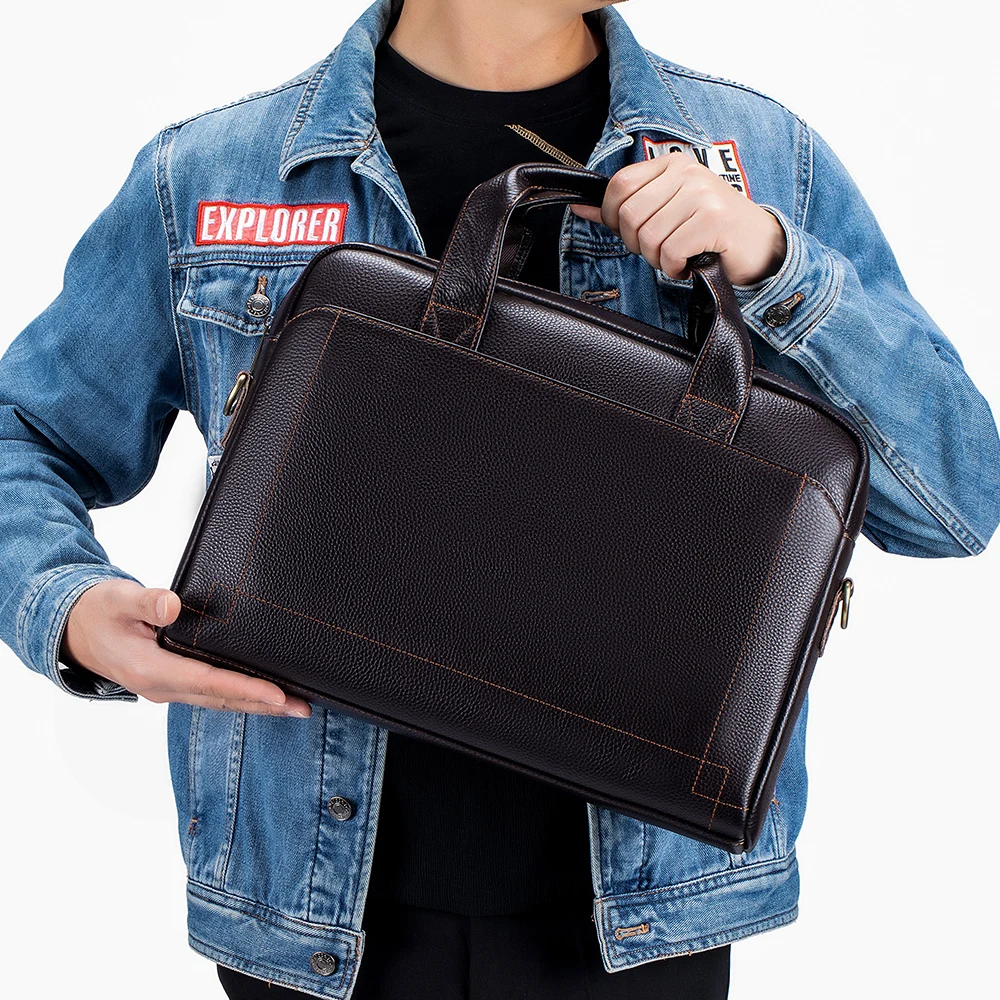
Advantages of Full-Grain Leather
• Unmatched Longevity: Full-grain leather items routinely last for decades rather than years, with proper care. The intact fiber structure creates extraordinary durability that improves rather than deteriorates with age.
• Distinctive Aging Process: The development of patina—that gorgeous deepening of color and increase in surface character—is unique to full-grain leather. This natural aging process means your item becomes more attractive over time.
• Natural Beauty: Each piece displays unique characteristics reflecting the animal’s life. These natural markings create one-of-a-kind items with authentic character.
• Excellent Air Circulation: The natural, open pore structure allows your leather to “breathe,” preventing moisture buildup and maintaining comfort against skin.
• Investment Value: Full-grain leather goods often retain remarkable value, with some vintage items actually appreciating rather than depreciating over decades.
The benefits of full-grain leather bags extend beyond simple aesthetics—they represent genuine value through extraordinary longevity and timeless appeal that transcends fashion trends.
Disadvantages of Full-Grain Leather
• Premium Price Point: Quality comes at a cost. Full-grain leather products typically command significantly higher prices than those made with processed leathers.
• Natural Imperfections: What leather enthusiasts see as character, some might view as flaws. Natural markings, small scars, and color variations aren’t uniform like mass-produced materials.
• Initial Care Requirements: Full-grain leather may require more attentive care, particularly in the early months of ownership, to develop proper conditioning and protection.
• Weight Considerations: The natural density that provides durability also makes full-grain leather somewhat heavier than more processed alternatives.
• Susceptibility to Staining: Without protective treatment, full-grain leather can be more vulnerable to staining due to its natural, open pore structure.
• Break-in Period: Some full-grain leather products require a “breaking in” period before achieving maximum comfort and flexibility.
What is Top-Grain Leather?
Top-grain leather represents the second-highest quality grade in the leather hierarchy. While it starts with the same upper portion of the hide used for full-grain, it undergoes additional processing that fundamentally changes its character and performance.
The defining characteristic of top-grain leather is the deliberate sanding or buffing of the leather’s natural surface. This process:
- Removes the outermost layer where the strongest fibers exist
- Eliminates or reduces natural markings, scars, and character elements
- Creates a more uniform appearance across the material
- Produces a smoother, more consistent surface texture
- Allows for easier application of finishes, dyes, and protective coatings
After sanding, top-grain leather typically receives additional treatments to enhance its appearance and performance. These often include:
- Application of artificial grain patterns to replace the removed natural texture
- Protective coatings to increase stain and water resistance
- Dyes and pigments for consistent coloration throughout the material
When choosing the perfect leather briefcase, understanding these processing differences helps explain why top-grain offers certain benefits while sacrificing others. The manufacturing process creates a more consistent product, but at the cost of some durability and natural character.
Key Characteristics of Top-Grain Leather
Uniform Appearance
Top-grain leather’s defining visual characteristic is its consistency. The sanding process removes natural variations, creating a smooth canvas that manufacturers can finish with uniform color and texture. This results in products with minimal variation between pieces—a quality valued in certain applications.
Moderate Durability
While not as durable as full-grain, top-grain leather still offers good durability compared to lower-quality options. The removal of the strongest surface fibers does reduce its longevity potential, but proper care can still yield years of reliable service from quality top-grain products.
Limited Patina Development
The finishing processes applied to top-grain leather create a surface that develops less distinctive patina over time. While some character develops with age, the protective coatings and artificial finishes limit the rich, organic aging process that makes full-grain leather so prized.
Reduced Breathability
Surface treatments and coatings reduce the natural porosity of top-grain leather. This diminished breathability makes the material somewhat less comfortable in applications where air circulation matters, such as footwear and furniture.
Enhanced Stain Resistance
The protective finishes applied to top-grain leather provide better initial resistance to stains and moisture. These coatings create a barrier that helps prevent spills from immediately penetrating the leather.
Initial Flexibility
Top-grain leather typically feels more supple immediately, requiring less break-in time than full-grain options. The processing that removes the dense top layer also makes the material more immediately pliable.
Advantages of Top-Grain Leather
• More Accessible Price Point: Top-grain leather offers a more budget-friendly option while still providing better quality than lower leather grades.
• Consistent Appearance: The uniform look appeals to those who prefer predictability over natural variations. Every piece looks essentially the same.
• Enhanced Stain Protection: Factory-applied finishes provide superior resistance to spills and stains right out of the box.
• Immediate Comfort: Less break-in time is required due to the softer, more flexible nature of processed leather.
• Color Variety: Top-grain readily accepts dyes and treatments, allowing for a wider range of consistent color options than full-grain.
The durability features of top-grain leather briefcases make them practical choices for many professionals who need quality without the highest price point.
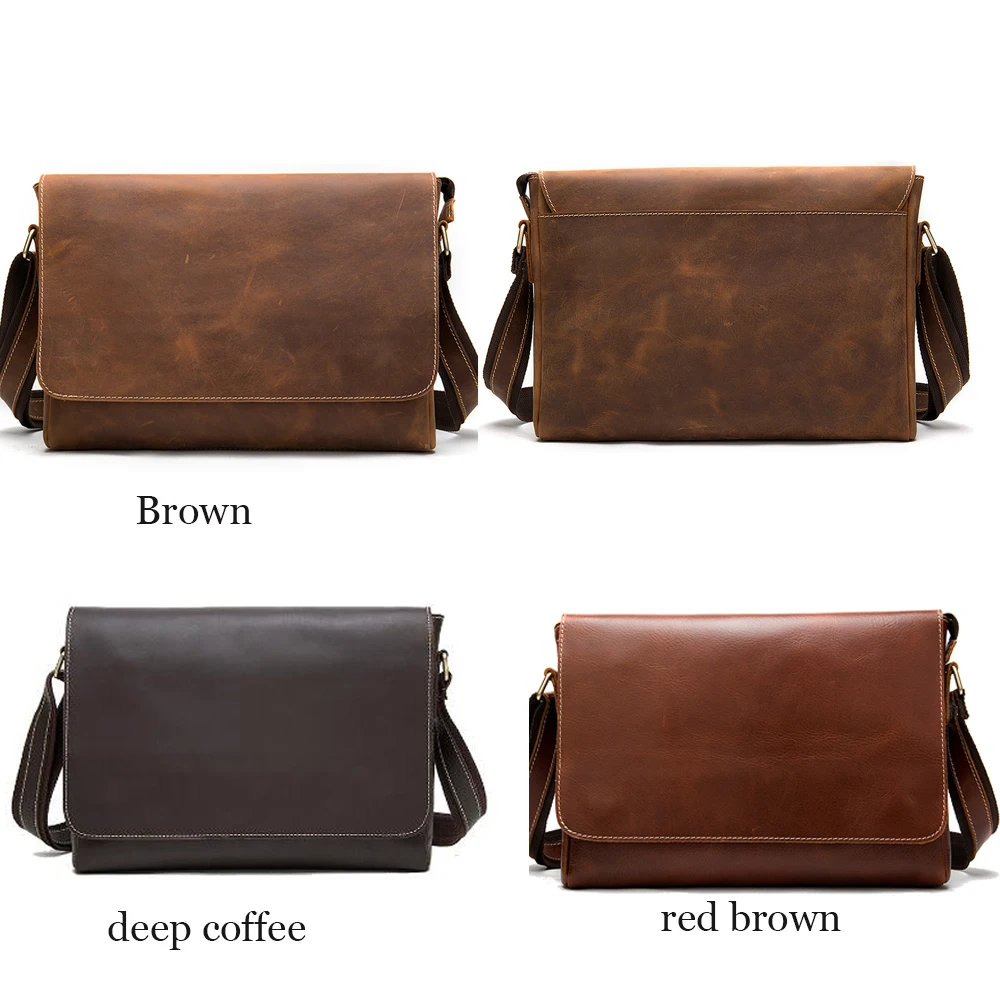
Disadvantages of Top-Grain Leather
• Shorter Lifespan: The removal of the strongest fiber layer significantly reduces long-term durability compared to full-grain leather.
• Less Character Development: Protective finishes inhibit the natural aging process that creates attractive patina in full-grain leather.
• Reduced Breathability: Surface treatments seal the pores that would naturally allow air circulation in untreated leather.
• Potential for Cracking: Rather than developing character with age, heavily finished top-grain can develop cracks as surface treatments break down.
• Wear-Through Concerns: The protective coatings may wear away unevenly over time, creating an inconsistent appearance.
• Less Natural Feel: The processing and finishing create a more artificial feel that lacks the warmth and tactile quality of full-grain leather.
Side-by-Side Comparison: Full Grain vs. Top Grain
| Feature | Full-Grain Leather | Top-Grain Leather |
|---|---|---|
| Processing | Minimal processing, natural surface intact | Sanded/buffed surface with added finishes |
| Durability | Exceptional, can last decades or generations | Good, typically lasts several years with care |
| Appearance | Natural variations, unique markings | Uniform, consistent between pieces |
| Patina Development | Rich, distinctive character develops over time | Limited aging character due to protective finishes |
| Breathability | Excellent air circulation through natural pores | Reduced breathability due to surface treatments |
| Cost | Premium price point | Moderate price point |
| Initial Feel | Firmer, requires break-in period | Softer and more flexible immediately |
| Stain Resistance | Natural resistance improves with conditioning | Better immediate resistance from factory finishes |
| Maintenance | Regular conditioning needed, develops character | Less initial maintenance, finishes eventually need renewal |
| Weight | Typically heavier | Usually lighter due to processing |
The most reliable way to distinguish between these leather types when shopping is to examine the edges and surface carefully. Full-grain leather shows natural texture variations and tiny pores visible under close inspection. The cut edge reveals tightly packed fibers throughout. Top-grain leather displays a more uniform surface with fewer visible natural characteristics and often has a slightly artificial sheen.
For more detailed information about these differences specifically in bag construction, the comparison of full-grain versus top-grain leather bags provides practical examples.
Which Leather Type is Better for Your Needs?
The “better” leather type depends entirely on your specific priorities and intended use. Here’s a framework to help determine which leather best matches your needs:
For Maximum Longevity and Character Development
Full-grain leather is clearly superior when your priority is creating an heirloom-quality item that will last for decades and develop distinctive character over time. The investment pays dividends through extraordinary durability and increasing beauty with age.
For Consistency and Lower Maintenance
Top-grain leather excels when you prefer predictable appearance and less intensive initial care requirements. Its uniform look and enhanced stain resistance make it practical for everyday use when absolute longevity isn’t the primary concern.
For Budget-Conscious Quality
Top-grain offers a sensible compromise when you want quality leather without the premium price of full-grain. It provides good performance at a more accessible price point, making it popular for mid-range leather goods.
For Professional Image and Impression
Full-grain projects subtle signals of quality and discernment in professional settings. For items that make a statement about your professional standards—like a briefcase you’ll carry daily—the investment often justifies itself through impression management.
When selecting leather goods, consider how the ideal leather briefcase should match your specific needs rather than simply assuming the highest grade is always necessary.
Best Applications for Full-Grain Leather
Full-grain leather shines in applications where longevity, character, and performance under stress are paramount:
• Heritage-Quality Briefcases and Work Bags: Professional items carried daily benefit from the exceptional durability and developing character of full-grain leather. Classic leather briefcases made from full-grain leather age gracefully through years of professional use.
• Investment Furniture: Sofas, chairs and ottomans that you expect to last for decades and pass down through generations.
• Quality Footwear: Boots and shoes subjected to repeated flexing and environmental stress hold up remarkably when crafted from full-grain leather.
• Belts and Straps: Items that must withstand constant tension and wear benefit from full-grain’s superior structural integrity.
• Heirloom Accessories: Wallets, portfolios, and items intended for daily use over many years develop beautiful patina and character.
The investment in full-grain makes particular sense for items that:
1. Experience significant physical stress
2. Benefit aesthetically from natural aging
3. Serve as expressions of personal quality standards
4. Will be used frequently over many years
Best Applications for Top-Grain Leather
Top-grain leather provides excellent value in applications where moderate durability with enhanced consistency and stain resistance matter most:
• Fashion-Forward Accessories: Items where current style and consistent appearance take priority over multi-decade longevity.
• Automotive Upholstery: The uniform appearance and good stain resistance make top-grain practical for vehicle interiors.
• Furniture in Active Households: Sofas and chairs in homes with children or pets benefit from the enhanced stain resistance.
• Colored Leather Goods: When specific, consistent color is a priority, top-grain accepts and maintains uniform dyes better than full-grain.
• Weather-Exposed Items: Products frequently exposed to moisture benefit from the added protective finishes.
Top-grain represents a sensible choice when:
1. Budget constraints make full-grain impractical
2. Consistency in appearance matters more than natural character
3. Resistance to stains and moisture is a primary concern
4. The item has a planned lifespan of several years rather than decades
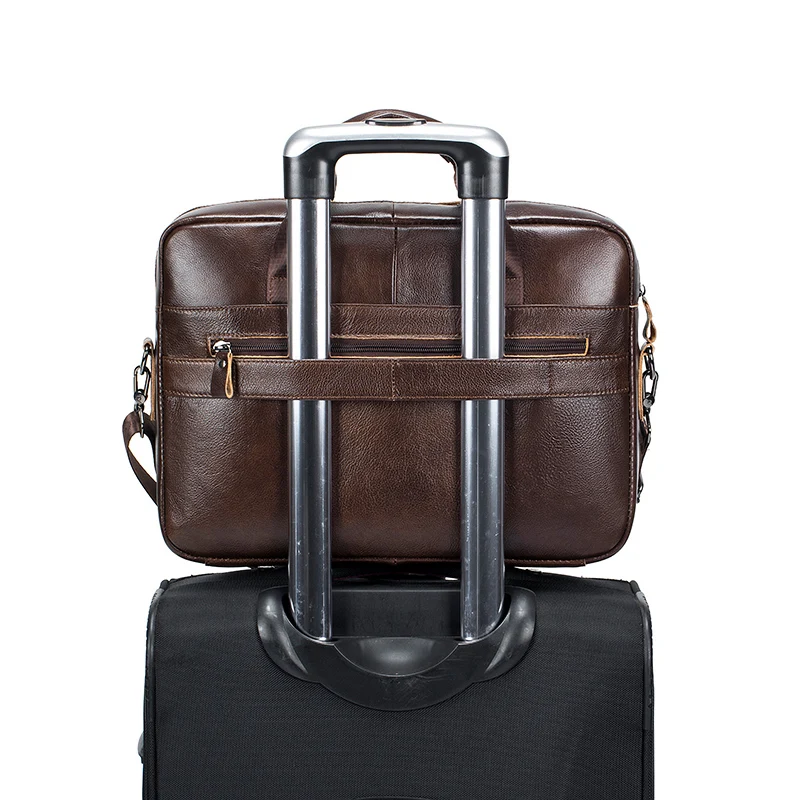
Understanding Price Differences and Value
The significant price difference between full-grain and top-grain leather reflects genuine differences in material quality, processing requirements, and performance expectations:
• Full-grain leather typically costs 50-100% more than top-grain for comparable items
• The price premium reflects both higher material costs and more demanding craftsmanship
• Skilled labor requirements increase with full-grain, as flaws cannot be sanded away
When evaluating value rather than just price:
• Consider cost-per-year-of-use rather than initial purchase price
• Factor in replacement costs for lower-quality items
• Evaluate how the item’s appearance will evolve over time
• Consider the item’s role in your professional or personal presentation
Classic leather briefcases for men in full-grain leather often represent better long-term value despite higher initial cost, particularly for daily use items that make a statement about your professional standards.
The value equation changes for different products and usage patterns. A full-grain sofa in a family room with young children might not be practical, while the same investment in a full-grain briefcase carried to client meetings could be entirely justified.
Men's Classic Leather Briefcase, Slim Leather Laptop Briefcase, Slim Leather Portfolio Briefcase
$93.67 Select options This product has multiple variants. The options may be chosen on the product pageClassic Laptop Briefcase, Men's Classic Leather Briefcase, Slim Leather Attache Case
Price range: $353.50 through $360.81 Select options This product has multiple variants. The options may be chosen on the product pageBlack Leather Briefcase, Leather Document Bag, Men's Classic Leather Briefcase
Genuine Crocodile Leather Executive Briefcase with Password Lock – Premium Business Document Carrier$1,201.87 Select options This product has multiple variants. The options may be chosen on the product pageBlack Leather Briefcase, Classic Laptop Briefcase, Men's Classic Leather Briefcase, Slim Leather Laptop Briefcase
$228.72 Select options This product has multiple variants. The options may be chosen on the product pageBrown Leather Briefcase, Classic Laptop Briefcase, Crazy Horse Leather Satchel, Men's Classic Leather Briefcase
Price range: $172.15 through $200.02 Select options This product has multiple variants. The options may be chosen on the product pageCrazy Horse Leather Satchel, Full Grain Messenger Bag, Men's Leather Satchel
$430.41 Select options This product has multiple variants. The options may be chosen on the product page
Caring for Your Leather: Maintenance Tips
Full-Grain Leather Care
• Regular Cleaning: Wipe with a slightly damp, soft cloth to remove dust and surface dirt. Avoid soaking the leather.
• Conditioning Schedule: Apply quality leather conditioner every 3-6 months depending on use and climate. Dry environments require more frequent conditioning.
• Proper Conditioning Technique: Use small amounts of conditioner, applied evenly with a soft cloth using circular motions. Allow to absorb fully before buffing.
• Storage Considerations: Store in breathable covers (never plastic) away from direct sunlight and heat sources. Maintain shape with appropriate stuffing for bags.
• Breaking In: Allow natural softening through use rather than forcing with excessive oils or treatments.
Top-Grain Leather Care
• Surface Cleaning: Use cleaners specifically formulated for finished leathers to maintain protective coatings.
• Protecting Finishes: Apply appropriate leather protector products to maintain the factory finish and stain resistance.
• Addressing Wear: Pay special attention to high-friction areas where protective finishes may wear away first.
• Avoiding Product Buildup: Use products sparingly to prevent residue accumulation that can affect appearance.
Understanding how to maintain a leather briefcase properly ensures you’ll maximize its lifespan and keep it looking its best through years of use.
How to Identify Full-Grain vs. Top-Grain When Shopping
Examine the Surface: Full-grain leather shows subtle natural variations and may have visible pores under close inspection. Top-grain looks more uniform with fewer natural markings.
Check the Edges: Look at cut edges—full-grain shows densely packed fibers throughout, while top-grain may reveal a more uniform interior with a distinct finished surface layer.
Perform the Fingernail Test: Gently drag your fingernail across the surface. Full-grain often shows slight temporary marks that fade quickly; heavily finished top-grain typically resists marking.
Assess the Scent: Full-grain has a richer, more natural leather smell; heavily processed leathers have a fainter scent or smell of chemicals.
Feel the Weight: Full-grain typically feels denser and slightly heavier for the same thickness.
Ask Specific Questions: Rather than just asking “Is this full-grain?”, ask about the specific processing—whether the surface has been sanded, buffed, or corrected in any way.
Consider the Price: Genuine full-grain leather commands a premium price that reflects its quality. Suspiciously low prices for claimed “full-grain” items warrant skepticism.
Understanding Other Leather Terms You May Encounter
• Genuine Leather: Despite sounding prestigious, this term actually indicates lower-quality leather, typically made from split leather with applied finishes. It’s technically “real” leather but from lower hide layers.
• Corrected Grain: A subset of top-grain leather where the surface has been more aggressively sanded to remove significant flaws, then embossed with an artificial grain pattern.
• Split Leather: Material created from the lower layers of the hide after the top has been separated. Significantly weaker than full or top-grain leather.
• Bonded Leather: Not truly leather but a manufactured material made from leather scraps and fibers bonded together with adhesives. Has very limited durability.
• Nubuck: Top-grain leather that has been sanded to create a soft, velvety surface similar to suede but more durable as it comes from the upper portion of the hide.
• Full-Aniline vs. Semi-Aniline: Terms describing dyeing processes—full-aniline uses only transparent dyes without surface pigments, showing all natural markings, while semi-aniline includes some pigmentation for more uniform color.
When defining the best leather briefcases, understanding these technical terms helps you evaluate marketing claims and determine the true quality of what you’re considering.
Frequently Asked Questions About Leather Types
Is top-grain leather “real” leather?
Yes, top-grain is genuine leather from the upper portion of the hide. It has been sanded and processed but is still natural leather, not a synthetic material.
Which leather type is more water-resistant?
New top-grain leather typically offers better immediate water resistance due to applied protective finishes. However, well-maintained full-grain leather develops excellent water resistance over time with proper conditioning.
Can top-grain leather develop a patina like full-grain?
Top-grain develops some character with age but significantly less than full-grain leather. The protective finishes and removed natural grain limit the distinctive patina development that makes full-grain cherished by enthusiasts.
Which leather is better for furniture that will get daily use?
For households with children or pets, top-grain often proves more practical due to better stain resistance and lower initial cost. For heirloom-quality pieces meant to last generations, full-grain provides unmatched longevity.
Is full-grain leather always thicker than top-grain?
Not necessarily. Both can be produced in various thicknesses depending on the application. The difference lies in the fiber structure and natural grain, not necessarily the overall thickness.
The Professional’s Choice: Why Full-Grain Leather Dominates Premium Work Bags
Professional work bags face unique demands that make full-grain leather particularly suitable:
• Daily Stress Factors: From overstuffed compartments to constant handling, professional bags endure significant physical stress that tests material strength.
• Impression Management: Your accessories make subtle but powerful statements about your professional standards. Full-grain leather communicates attention to quality details that align with high professional standards.
• Professional Patina: Well-aged full-grain leather signifies experience and established success—the bag shows you’ve been in the professional world long enough to develop both your career and your accessories.
• Investment Perspective: Professionals often take a long-term view of their career investments. A quality full-grain professional leather briefcase represents wise resource allocation when amortized over decades of use.
Full-grain leather’s ability to maintain structural integrity while developing distinguished character makes it particularly suitable for the professional environment. The initial investment returns dividends through longevity, appearance, and the subtle messages it communicates about your professional values.

